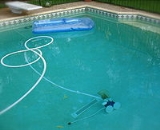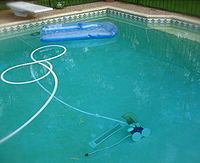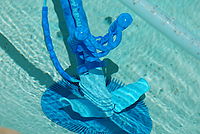
Automated pool cleaner
Encyclopedia

History
The first swimming pool vacuum cleaner was invented by Ferdinand Chauvier in South AfricaSouth Africa
The Republic of South Africa is a country in southern Africa. Located at the southern tip of Africa, it is divided into nine provinces, with of coastline on the Atlantic and Indian oceans...
, a hydraulics engineer who came to South Africa from the Belgian Congo
Belgian Congo
The Belgian Congo was the formal title of present-day Democratic Republic of the Congo between King Leopold II's formal relinquishment of his personal control over the state to Belgium on 15 November 1908, and Congolese independence on 30 June 1960.-Congo Free State, 1884–1908:Until the latter...
in 1951.
Chauvier continued to tinker with machines, eventually creating one that would do the job automatically, powered by the operation of the pool's filter. In 1974 he finished work on the first automatic pool cleaner and marketed his product under the name Kreepy Krauly.
Types
.jpg)
- Return-side driven—water outflow being returned to the pool is used for locomotion and debris suction, via the venturi effectVenturi effectThe Venturi effect is the reduction in fluid pressure that results when a fluid flows through a constricted section of pipe. The Venturi effect is named after Giovanni Battista Venturi , an Italian physicist.-Background:...
. - Pressure driven—a minor variation of return-side driven, water outflow is pressurized using a secondary "booster" pump. This high pressure water is used for locomotion and debris suction, via the venturi effectVenturi effectThe Venturi effect is the reduction in fluid pressure that results when a fluid flows through a constricted section of pipe. The Venturi effect is named after Giovanni Battista Venturi , an Italian physicist.-Background:...
. - Suction-side driven—water being pumped out of the pool via its skimmer or drains is used for locomotion and debris suction.
- Electronic & Robotic—an external electrical power cord is used to drive motors used for locomotion and suction.
Return-side driven
These types of cleaner require high amounts of flow for movement, and as a result may require a dedicated pump (see Pressure driven section below) or adjustment of returns to provided adequate flow to the cleaner.The venturi effect
Venturi effect
The Venturi effect is the reduction in fluid pressure that results when a fluid flows through a constricted section of pipe. The Venturi effect is named after Giovanni Battista Venturi , an Italian physicist.-Background:...
forces the cleaner forward and allows it to remove of dirt, this dirt and water mixture is directed through a filter bag.
Although a number of older pool cleaners used this process in the past it has fallen out of favour due to high running costs of additional pump & adjustment of return pipework flows.
Pressure driven
This type is identical in principle to the return-side driven, except that a dedicated booster pump is used to provide additional water pressure and flow.Although a number of older pool cleaners used this process in the past it has fallen out of favour due to high running costs of an additional pump.
Suction-side driven

Electronic pool cleaners
The central component of the electronic pool cleaner is the motor block, which consists of a drive motor, a pump, and a processor.As the pump motor draws water in through the bottom of the cleaner, this water travels through filter bags and out the top outlet of the cleaner, which also provides the suction that allows it to clean the sides of the pool. During this cleaning process debris and sand are vacuumed into the filter bags until the programmed cycle is completed. When the cleaner is removed from the pool the filter bags should be emptied and washed by hand before being used again.
The pool robot moves forwards and backwards through the use of wheels or tracks, which are driven by belts connected to the drive motor. Many of these pool cleaners have a third motor called a foot motor which presses down a rubber foot in order for it to turn and change direction
The processor is configured to an operating time appropriate for the size of the pool.
Robotic pool cleaners
They operate using sensors located in the bump bars, on contact with objects such as a walls they pause the machine briefly. The electronics will then restart the machine and reverse its direction. When this happens it returns in the same direction with a small offset allowing it to move one machine's width over on each crossing of the pool.Cleaners can be equipped with a timer allowing the machine to start and stop after an adjustable period of time. This delay timer is an important feature for many pools, as many switch off a number of circulation pumps during the night to allow suspended particles to settle on the bottom of the pool; after a couple of hours the pool cleaner begins its cleaning cycle. This cleaning cycle is set up to complete before the pumps are turned back on; this maximizes the cleaning capability of the cleaning cycle. This isn't a necessity as the cleaning capability of the pool cleaner is still considerably high regardless of the circulation pumps.
Unlike hydraulic pool cleaners, these are fitted with thick rotating brushes that thoroughly scrub the tiles clean and trap the dirt in washable filter bags. Suction power is used to grip the floor, ensuring the tiles are scrubbed clean and debris is removed from the pool.

